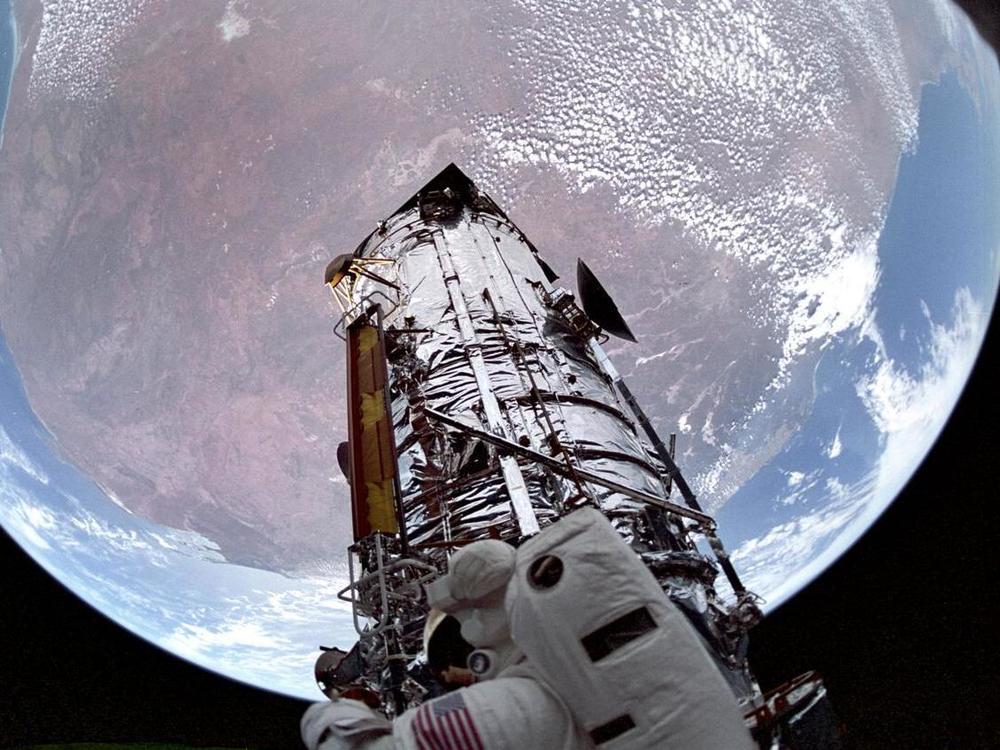Section Branding
Header Content
Astronomy's contribution to climate change rivals the emissions from some countries
Primary Content
Astronomers spend their careers looking up at the sky, away from Earth, but now some stargazers say their field has to grapple with the fact that observing the cosmos is contributing to their home planet's climate emergency.
A new estimate of the greenhouse gas emissions linked to all ground- and space-based telescopes, in the journal Nature Astronomy, says the annual carbon footprint of astronomy's research infrastructure is equivalent to about 20 million metric tons of carbon dioxide.
"Just to give you some perspective — 20 million tonnes of CO2 — this is the annual carbon footprint of countries like Estonia, Croatia, or Bulgaria," says Jürgen Knödlseder, an astronomer at IRAP, an astrophysics laboratory in France.
He and IRAP colleagues including Annie Hughes and Luigi Tibaldo got the idea to do this study while making an estimate of the greenhouse gas emissions from their own institute.
"The only missing piece of our assessment was the footprint of the observational data," says Knödlseder, whose own research, for example, has relied on observations made with the Fermi Gamma-ray Space Telescope.
"No study had ever tried to calculate the carbon emissions due to the construction and operation of all the telescopes and space missions that astronomers use to make observations," notes Hughes.
That's just what this research team set out to do. Data were sometimes hard to come by, but they did their best to approximate and tally up greenhouse gas emissions associated with nearly 50 space-based missions and 40 ground-based telescope facilities.
The most prolific emitters were the biggest, most expensive observatories, such as the new James Webb Space Telescope and the Square Kilometer Array, according to the report.
By dividing up the total annual emissions by the number of astronomers worldwide, the researchers figure that each astronomer's share of the profession's emissions is around 36 metric tons per year.
Knödlseder points out that this is about the amount of emissions from driving an average car in France 165,000 kilometers, or over 100,000 miles.
And that's just from using the telescopes — it doesn't include things like scientists' travel to conferences, supercomputing power and office heating. "For our lab, the total is actually about 50 tonnes of equivalent CO2 per year an astronomer," he says.
Hughes believes that astronomers need to set an example when it comes to action to mitigate climate change. "If we as scientists do not react to the reports and warnings from our colleagues," she says, "then it's a bit like your dad telling you that you shouldn't smoke, while he himself is smoking a cigarette. Why would you take his word seriously?"
The researchers urge space agencies and funders of astronomical research to commit to requiring an environmental assessment of every observing facility they support, and making them public.
What's more, they say, until research can be made more sustainable, through measures like renewable energy sources, one option to reduce emissions is to slow down the pace of building ever larger and more sophisticated new telescopes.
"Some of our colleagues are a bit shocked by this idea," says Tibaldo. "What we really think is that these options must be on the table. The emergency we are facing is so big and clearly we are playing a role in it with our work."
The astronomers hope that other scientific fields will be inspired to take a similar global inventory of the greenhouse gas emissions from their research infrastructure. "As far as I know," says Knödlseder, "this is the first time that this kind of study has been done for any research field."
This study is important because it draws attention to the contribution of astronomy to climate change, says Travis Rector, an astrophysicist at the University of Alaska Anchorage who is one of the organizers of the group Astronomers for Planet Earth.
"I think the overall picture is clear that we do have substantial emissions associated not only with the operations of our facilities, but also the construction," says Rector. "And this is something we've been aware of for some time. And there are efforts to try to reduce the emissions associated with those."
Already, some observatories either use solar power or are looking into greener energy options. A spokesperson for the National Science Foundation, a major funder of astronomy research, told NPR that "we have explored and implemented clean energy alternatives, such as installing solar panels at our Gemini North and South facilities, and we built the possibilities of future solar upgrades into the buildings."
Astronomers have also been discussing the climate impact of travel to in-person professional conferences. During the pandemic, Rector notes, virtual conferences drew even more participants than past events, suggesting that there had previously been unrecognized barriers to participation.
"This has been an opportunity for us as a profession to think critically about how is it that we do our business," says Rector. "Are there ways that we can do it that reduce our carbon emissions and actually make this more scientifically productive?"
Even though astronomy is a relatively small profession and may have less of a climate impact than some other human activities, he says, "that doesn't give us the right to say, well, this isn't our problem. We recognize that we are — that we need to be part of the solution as well."
Copyright 2022 NPR. To see more, visit https://www.npr.org.

